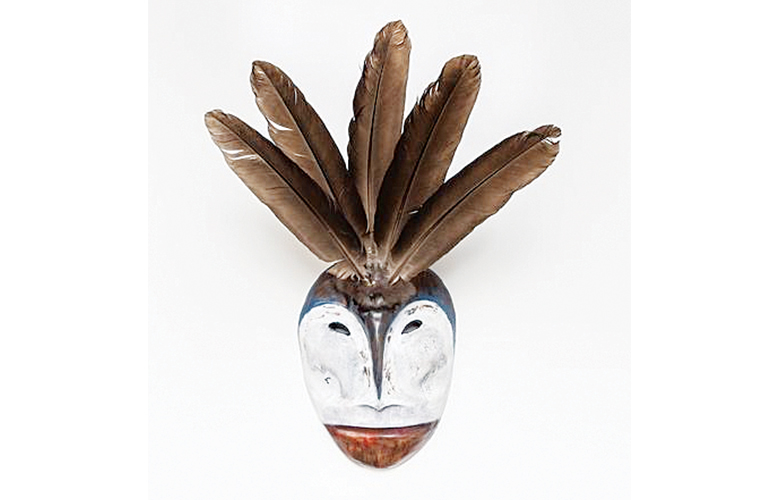(Artwork above: Maker Raven – Pushing Back the Mask by Terresa White)
A bronze sculpture depicts a Yup’ik Eskimo performing an ancient dance and transforming into a walrus mid-sway. A ceramic mask of a sea otter on its back reveals it stomach to be a human’s face, ready to devour a small fish. These images are both powerful and ethereal in announcing the Yup’ik Peoples world, consciousness, and metaphysical connections. In order to create the works, Terresa White must flow into the mystical realms of her grandmother, her grandmother’s grandmother, and their handed down oral stories of the subarctic world. Imbued with this ancestral awareness, she shares these perspectives about the distant lands in contemporary art forms.
Terresa grew up in Rainier, Oregon, 2000 miles away and a full generation removed from her family’s remote homelands in Western Central Alaska. Her grandmother Clara and great aunts were forcibly taken from their home in remote Alaska for the purpose of educating them in Western World schooling so as to ‘civilize them.’ Clara, living in Fairbanks, AK with a young daughter who would become Terresa’s mother, married a man of German descent; the family resettled in Oregon. Clara’s sisters followed.
Though fluent in their own language, they formed a community within a community and, in the English language, taught their children the Yup’ik perspectives, culture, and values, while never identifying that the family’s norms, organization, and virtues were derived from a completely different environment and culture. Terresa became a tribally enrolled member of the Yup’ik People, and her traditional tattoos—three lines from the lower lip to chin— express that identity and heritage.
Terresa’s account of her identity and artistic beginnings coming together—
I experienced Eskimo dancing for the first time in a field in rural Oregon with my Granny, Aunties, Mom, and Cousin. We’d been invited by an acquaintance from the Northwest Inupiaq Dancers to attend their gathering. The drums, songs, and dances lit a circle in the grass around our gathering. They cleared a path to my heart’s home! We danced the closing song with the group—it was my first time dancing, and my thousandth time, I knew it by heart and found myself dancing with my eyes lowered and my vision soaring. I left the gathering inspired to dance and compelled to create.
For years my hands had been itching to make and they saw a path in the traditional, carved wood masks worn by the dancers that day in the field. I joined the dance group after that, found my way to other Alaska Native friends in the Portland and Seattle areas, and soon sculpted my first mask from clay. It was a self-portrait mask, white-faced and wrinkle-eyed, its berry-stained mouth grinning wide.
The transformation masks that followed were born of Yup’ik and other Eskimo stories. They express my understanding of the personhood and interrelationship of all human and non-human beings. Walrus Dance Transformation, my first bronze sculpture, had its inspiration in the powerful masked Walrus Dance I saw performed that day in rural Oregon.
On August 17 , Terresa received First Place for Class (Bronzes) and First Place for Division (Sculptures) for the work Sedna at the premier Native American art show The Santa Fe Indian Market, held the third weekend of each August. For the next year at least, Terresa now enjoys status as one of the elite Native American artists.
Terresa will be offering an in person show in Sisters September 7-9, with an Artist Reception on Friday from 4 to 7pm. All events will take place at Raven Makes Gallery on Hood Avenue.

